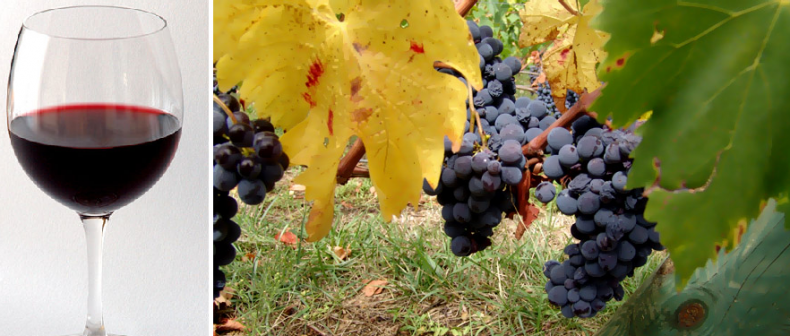
All Images and Composites via Flickr
Despite the beating that merlot took in the 2004 film Sideways, it remains extremely popular. And for good reason: It’s appealing, soft and plush, with suave tannins and an inviting, velvety texture. Merlot displays less of the herbaceous aspect of the other Bordeaux grapes, and plenty of ripe plum and blackberry fruit, thanks to its facility to ripen. It’s harvested a little earlier than, say, cabernet sauvignon, making it suitable to a wide range of terroirs and climates such as Bordeaux’s right bank, where cabernet would struggle to reach maturity in the cooler, wetter clay soils of appellations like Pomerol and St. Emilion. Thus you’ll find it from Patagonia to the Niagara Peninsula, from San Francisco to Jerusalem to Melbourne; virtually everywhere, save for the most extreme hot and cold regions.
Merlot’s flavour profile is also well suited to the chocolaty, sweet spice and caramel flavours imparted by the oak barrels in which it is frequently aged, further increasing the general commercial appeal. And when it’s good, it is very, very good, developing intriguing truffle and Christmas-cake flavours as it ages. But when it’s poor, it’s about as banal and generic as it gets; unidentifiable fermented red grape juice. There are fewer and fewer truly exciting examples under $20, it seems. So, you may want to consider leaving the safety net of merlot and exploring new grapes that can deliver a similar profile at a fair price.
If you like merlot, you’ll probably also like:
- MencÃa
- Tempranillo
- Agiorghitiko
MencÃa is the headline grape in the Bierzo region of northwestern Spain. It’s described by local winemakers as amable, literally ‘lovable’ and makes some of Spain’s most elegant reds. It reaches full maturity at moderate alcohol levels, while the tannins are soft and plush. The wines grown on the steep, high elevation slate-covered hillsides near the village of Corullón are leaner, supremely elegant, more mouth-watering and decidedly more mineral and floral; those from the lower, clay-rich gentle slopes between Villafranca, Valtuille and Cacabelos have a broader, softer profile with a voluptuous, velvety texture, deep dark fruit and soothing power. In any case, these are wines of immense appeal. You’ll also find mencÃa across the border in Portugal where it’s called jaen, especially the Dão and Douro, though it’s most often blended with other varieties.
Tempranillo is another quality Iberian grape, whose names derives from temprano or “early,” since, like merlot, it’s an early ripener. It goes under a wild number of aliases across the peninsula (e.g. tinta roriz, aragonés, tinta de Toro, ull de llebre, tinto fino, tinto del pais). You’re probably familiar with it already if you’ve drunk wines from Ribera del Duero, Toro or Rioja (though it’s often blended in the latter appellation). Like merlot, it changes character from region to region: in the lower lying, hotter vineyards of DO Toro, it produces quite massive, chewy wines with alcohols approaching 15 per cent. In the cooler highlands of Ribera del Duero, Rioja Alta and Alavesa, it comes out more refined and polished, with silky tannins and ripe, red and dark fruit character. You’ll find it in soft but juicy, low or no-oak styles, or more traditionally in Spain, with plenty of sweet toasted coconut oak flavours. Its suitability to a broad range of conditions has encouraged plantings around the world; it’s been spotted (and tasted) in Argentina, Chile, Australia, Israel, California and Greece.
Agiorghitiko! [ah-yor-YEE-ti-ko] One of the noblest, if tough-to-pronounce Greek red grapes, agiorghitiko is occasionally labeled under the English translation, St. George. Its home base is the appellation of Nemea in the northeastern Peloponnese, about an hour and a half from Athens. It yields wines that stand out for their deep red color and remarkable aromatic complexity, not to mention wide appeal. Like merlot, it has soft, plush tannins, and balanced acidity, with flavours ranging from ripe strawberry to deeper, darker plumy fruit. It, too, is well suited to barrel ageing, further polishing texture and adding the toasty notes beloved by many. The Greeks call it a ‘polyvalent’ variety, meaning that it can be produced in many styles, from light, fresh rosé in the cooler zones, to rich, sundried sweet grape wines. The best, however are the classic, age-worthy reds in between. Prepare to see agiorghitiko increasingly from other regions of Greece, and even other countries.
_____
John Szabo is a master sommelier and wine writer for Toronto Standard. Follow his tweets here: @johnszabo.
More recommendations by John Szabo at www.johnswines.com
For more, follow us on Twitter @TorontoStandard and subscribe to our newsletter.














